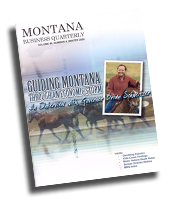MONTANA BUSINESS QUARTERLY
Volume 46, Number 4, Winter 2008 |
|||
 |
Guiding Montana Through an Economic StormAn Interview with Governor Brian Schweitzerby Patrick Barkey and Shannon Furniss |
||
Governor Brian Schweitzer met with Patrick Barkey, director of the Bureau of Business and Economic Research, and Shannon Furniss, editor of the Montana Business Quarterly, to discuss statewide economic issues and plans for his second term. | |||
The Business of Gambling in Montanaby John Baldridge and James T. Sylvester |
While it's still too early to tell the impacts of the recession sweeping Montana and the rest of the nation, gambling establishments may be hurt by the recent drop in consumer spending at about the same rate as other retail operations. However, revenue from recreational gambling, complemented by sales of products like beer, liquor, and even gasoline, may be less sensitive to a decline in overall consumer spending than revenue from other recreational pursuits. |
Are Montana Roads Becoming Safer?Traffic Safety and Other Findings from the 2008 Montana Kids Count Data Bookby Thale Dillon |
Traffic safety and other findings are detailed in a summary of the 2008 Montana Kids Count Data Book. The book is a statistical summary of the well-being of children and vulnerable families in the state. |
Motor Vehicle Death RatesRural Highways and Drinking Put Montana Teens at Higher Risk than Other Statesby Thale Dillon |
Sparsely populated, with miles of rural highways and alarmingly high rates of teenagers who drink alcohol and drive, Montana has consistently shown higher death rates for children and teens than most other states in the nation. While the total death rates are the result of numerous causes, the leading cause of death for youth under 19 in Montana and throughout the nation is motor vehicle accidents. |
Polzin Retires as Bureau Directorby Shannon Furniss and Amy Joyner |
Paul E. Polzin, Director of the Bureau of Business and Economic Research, retired in June. During Polzin's directorship, the Bureau has thrived and grown from eight employees to 18 full-time workers and fields more than 6,000 requests each year from people seeking economic information. |

